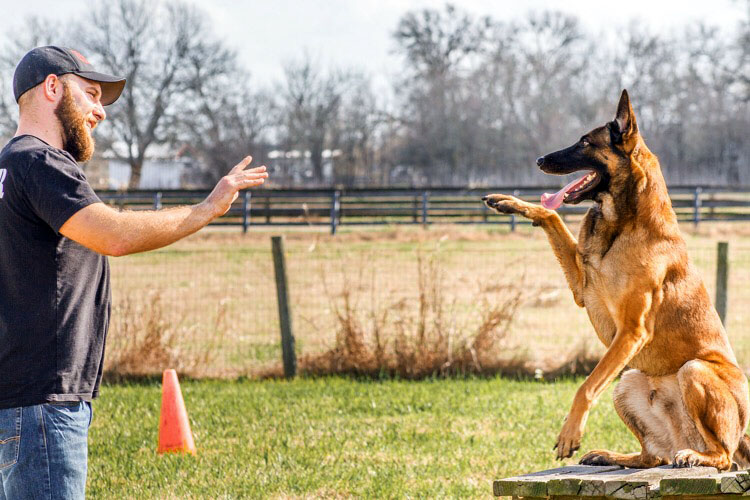Just how to Pick the Right Approach for Effective Dog Training
Just how to Pick the Right Approach for Effective Dog Training
Blog Article
Important Tips for Effective Dog Training: An Overview for Pet Owners
Effective dog training is a diverse process that calls for a tactical strategy customized to both the pet's temperament and the proprietor's purposes. Comprehending how to navigate these obstacles can substantially boost the training experience, inevitably transforming the relationship in between owner and canine.
Comprehending Canine Habits
Comprehending canine actions is necessary for effective training and cultivating a harmonious connection between canines and their owners. dog training. Canines communicate mainly through body language, articulations, and activities, making it crucial for owners to interpret these signals precisely.

Socializing plays a substantial duty in pet dog habits; direct exposure to different environments, individuals, and other pets can significantly impact a pet's temperament. Additionally, variables such as breed attributes and individual personality need to lead training techniques, as some breeds might have particular behavior attributes that demand customized approaches. By recognizing these aspects, owners can produce a helpful environment that motivates positive actions, leading to effective training end results and a deeper bond with their pets.
Developing Constant Commands
Reliable interaction with your dog starts with establishing consistent commands. This foundational component of training is crucial for promoting understanding in between you and your pet dog. Uniformity in the commands you utilize ensures that your pet dog can reliably connect specific words or phrases with the desired behaviors.
When selecting commands, pick clear, distinctive words that are easy to separate and state from one another. Stay clear of making use of similar-sounding commands that may puzzle your pet dog. Utilizing "rest" and "stay" is proper, yet "rest" and "hit" can lead to misconceptions.
Additionally, preserve the very same tone and quantity for every command. Pet dogs are delicate to singing hints, so varying your tone can produce complication.
It is similarly important to make sure that all relative are on the exact same page pertaining to the commands made use of. A united front in command use will protect against blended signals and enhance the understanding process.
Positive Support Techniques
The power of favorable reinforcement in dog training hinges on its capacity to urge wanted behaviors through benefits and praise. This method is grounded in the principle that behaviors complied with by desirable outcomes are much more most likely to be repeated. By including positive reinforcement into your training program, you can effectively shape your canine's behavior in a constructive manner.
To implement favorable reinforcement, it's necessary to identify what motivates your pet dog, whether it be deals with, toys, or spoken praise. When your pet does a wanted action, such as resting on command, promptly compensate them with a treat or love. This organization between the command and the favorable outcome strengthens their more helpful hints understanding.
It's crucial to timing the benefits correctly; supplying the support within secs of the desired habits aids your pet make the connection (dog training). In addition, uniformity is key-- ensure that all member of the family use the exact same commands and benefit systems to avoid hop over to here confusion

Gradually, you can reduce the frequency of treats as your pet dog finds out the actions, transitioning to commend or intermittent benefits. This technique not just promotes a solid bond in between you and your canine but also advertises a positive learning setting, making training a satisfying experience for both.
Socialization and Communication
Continually revealing your pet dog to a selection of atmospheres, individuals, and various other animals is crucial for their social development. Socialization needs to begin early, preferably during the important window of 3 to 14 weeks, when puppies are most responsive to brand-new experiences. Nonetheless, older canines can also benefit from recurring socialization initiatives.
Introduce your canine to different setups, such as parks, pet-friendly stores, and city areas. This direct exposure assists them adjust to various stimulations, decreasing anxiousness and anxiety reactions. Motivate positive communications with other canines and individuals, making certain that these experiences are risk-free and regulated to promote confidence.
Use organized playdates with well-mannered dogs, as this can enhance your pet's social skills and educate them ideal behavior. Obedience classes and training sessions additionally provide excellent possibilities for socializing, allowing your pet dog to engage with others in a supervised setting.
Display your dog's body movement throughout communications, as this will certainly assist you determine their comfort degree. Slowly increase exposure to more difficult scenarios while making sure that each experience is favorable. A well-socialized canine is much more likely to show well balanced behavior, making them a happiness to have in any type of setup.
Dealing With Usual Training Challenges
Every pet dog owner will experience training obstacles at some factor, no matter their canine's age or socializing level. Determining typical problems such as stubbornness, disturbances, and fearfulness can help in developing efficient techniques for improvement.

Disturbances throughout training sessions can derail focus. To combat this, begin training in a silent atmosphere with minimal stimulations. Gradually introduce diversions as the pet comes to be extra efficient in commands. Short, regular training sessions are additionally reliable in preserving interest.
Fearfulness can impede a pet's understanding procedure. Progressive desensitization to the source of fear, coupled with favorable index support, can assist reduce anxiety. Patience is important; never ever compel a dog right into a circumstance that causes distress, as this may aggravate the concern.
Ultimately, understanding and dealing with these typical difficulties with a structured approach will certainly foster an extra productive training experience, strengthening the bond between canine and owner while promoting reliable learning.
Verdict
In recap, effective pet training relies on a thorough understanding of canine habits, the establishment of regular commands, and the application of positive reinforcement techniques. Socializing plays a crucial duty in creating well-adjusted animals, while dealing with common training challenges requires patience and adaptability. By executing these necessary strategies, pet owners can foster a strong bond with their canines and advertise desirable habits, inevitably resulting in an unified relationship between people and their canine companions.
Recognizing dog actions is vital for efficient training and fostering a harmonious connection in between canines and their owners.Socializing plays a significant duty in canine actions; direct exposure to numerous environments, people, and other animals can considerably affect a dog's temperament.The power of positive support in pet dog training lies in its capacity to encourage wanted behaviors via benefits and praise. By integrating positive reinforcement right into your training regimen, you can efficiently form your pet dog's habits in a positive manner.
In summary, successful dog training relies on a thorough understanding of canine actions, the facility of constant commands, and the application of positive support strategies.
Report this page